|
|
U.S. GLOBEC studies in the NE Pacific are underway, with preliminary modeling, monitoring, and retrospective analyses having already begun. Two geographical foci have been selected for GLOBEC research in this region:
- The California Current System off Oregon and N. California. U.S. GLOBEC studies in this area will concentrate on the effects of wind-driven processes on local productivity, and the dynamics of target salmon, copepod and euphausiid species. The productivity of the California Current System (CCS) is strongly influenced by upwelling of cold, nutrient-rich water as offshore winds push surface waters away from the coast. The well-known El Niño phenomenon interrupts this process when wind fields weaken and transport of surface waters is diminished ....
- Coastal Gulf of Alaska. U.S. GLOBEC studies in this area will provide contrasting information to the CCS, and will concentrate on the importance of buoyancy-driven flows and the roles of downwelling and stratification on distribution, growth, and survival of the target species ....
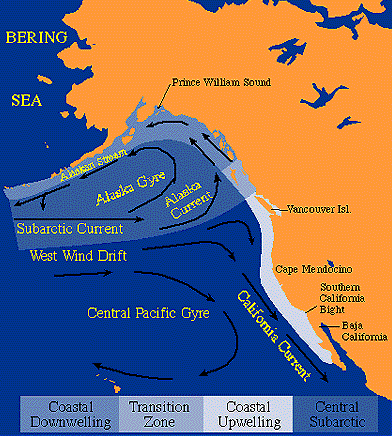 Major ocean current systems and production domains in the Northeast Pacific region .... |
Cross-comparisons between the California Current and the Coastal Gulf of Alaska systems are an essential component of the Northeast Pacific GLOBEC Program. Abundance of salmon in these two areas have varied out of phase for much of the last century. Comparative analysis of the salmon populations in the two regions may provide important insights into the factors controlling abundance fluctuations in these species ....
GLOBEC field studies in the Northeast Pacific encompass:
- Long-term observation programs (LTOPs) along established transects at bimonthly intervals,
- Meso-scale sampling programs (ca. 3 / year) which complement the LTOP sites by providing more intensive spatial resolution of key physical and biological parameters, and
- Process-oriented studies of physical and biological processes that control population dynamics of the target species. ....
California Current System
Long-term changes in conditions in the California Current System have been recorded over the last century. Increasing temperatures have been linked to changes in species composition, and in turn these changes are thought to be related to global climate change. Changes in the productivity of salmon species in California and the Pacific Northwest have been linked to changes in upwelling regimes and overall levels of productivity ....
Pacific salmon in this region are also critically threatened by water use practices, damming of rivers, pollution, and fishing pressure. These species breed in freshwater systems, and the young eventually leave the rivers to enter the marine environment where they undertake extensive migrations before returning to their natal rivers to spawn. The number of fish surviving to return to the rivers is affected by conditions they encounter in the ocean environment as well as fishing mortality ....
The goal of GLOBEC studies in the California Current is to examine the implication of climate change affecting upwelling processes, stratification, and transport of the target species - coho and chinook salmon - and their zooplankton prey (including the target calanoid copepod taxa and euphausiid species). The first year of GLOBEC process studies in the California Current began in 2000 ....
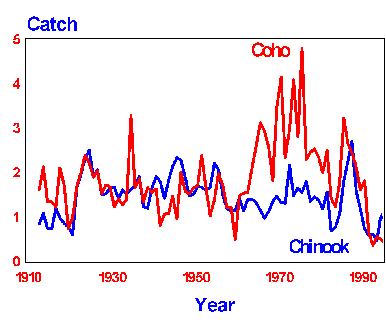 Historic landings of Coho and Chinook Salmon in Washington, Oregon, and California .... |
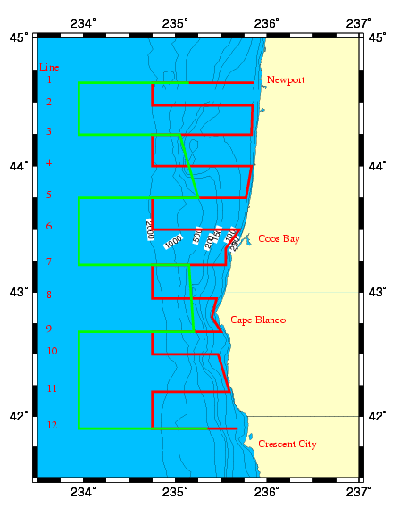 LTOP (lines 1, 3, 5, 7, 9, and 12) and Meso-scale sampling locations off the Oregon and Northern California coasts .... |
Coastal Gulf of Alaska
U.S. GLOBEC will begin process studies in the Coastal Gulf of Alaska starting in 2001. GLOBEC research in this region will focus on the importance of climate-induced changes in freshwater discharge into the Gulf and its effect on currents; the role of downwelling; andtransport processes for the target species: pink salmon, euphausiids, and several copepod taxa. Important indicators of the role of climate fluctuations on the production of pink salmon can be discerned in records of temperature change and fishery landings for this species spanning the past 80 years. Long-term variation in temperature in the Northeast Pacific follows a multi-decadal pattern which is also manifest in salmon catches in the Northeast Pacific ....
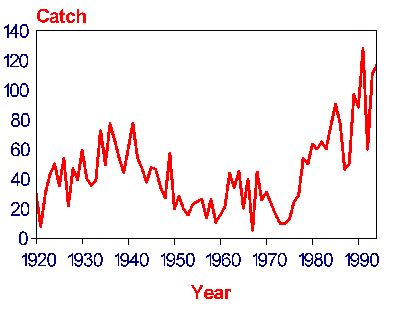 Alaska landings of pink salmon .... |
A long-term observation program has been implemented in the Coastal Gulf of Alaska adjacent to Prince William Sound, and both modeling and retrospective analyses are now underway in this region ....
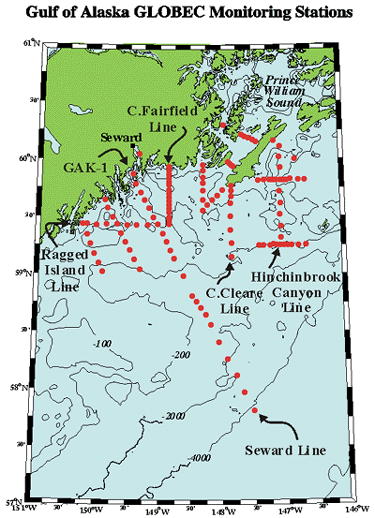 Location of long-term observation sites in the Coastal Gulf of Alaska .... |
[ Table of Contents ]
[ Top of Current Page ]
[ Advance to Next Section ]

 Northeast Pacific Program
Northeast Pacific Program


